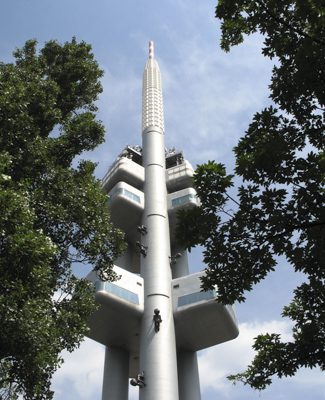July 9 to 16, 2005
We flew overnight from JFK Airport to Prague, Czech Republic. We arrived early in the morning and checked into the very modern Maximilian Hotel. We chose the hotel because it was located in the historic district of the capital city and was within walking distance to most tourist sights.

Prague, Czech Republic is a beautiful historic city with lovely decorated buildings, narrow cobblestone streets, and charming tiled sidewalks.

Old Town Square (Staromestske Namesti) is the oldest and most significant square in the historical center of Prague. Its history dates to the 10th century when it was a major marketplace.

Overlooking the Old Town Square are the tall spires of the Church of Our Lady Before Tyn, which was completed in the 15th century. The red-roof building on the left in the photo below is the National Gallery, home to a large European art collection.


The huge Jan Hus Memorial stands in the Old Town Square. It was dedicated in 1915 to commemorate the 500th anniversary of Jan Hus’ martyrdom. Hus was a 14th century Czech theologian and church reformer who was executed for heresy against the Catholic Church in 1415.

Prague’s Jewish Quarter (Josefov) survives after centuries of discrimination and cruelty to the thousands of people who were forced to live in the squalid conditions of a “Ghetto.” Fortunately, several significant historical buildings were saved from destruction and are a testimony to the history and resiliency of the Jewish people.

Maisel Synagogue, built in 1590, is part of the Jewish Museum in Prague. A permanent exhibit tells the story of the “Jews in Bohemia: 10th-18th centuries.”

The Ceremonial Hall of the Prague Jewish Burial Society:

The Old Jewish Cemetery:

Lovely quaint street in Prague:

View of the magnificent Charles Bridge – Karluv Most – built in 1357 which crosses the River Vltava:

Prague Castle was once the home of Bohemia’s kings and today is the residence of the Czech Republic’s president. Originally built as a walled fortress in 870AD, it is the largest castle complex in the world.

St. Vitus Cathedral (constructed in 1344) is located within the the castle walls and is an interesting place to visit:



The statue of two male figures was public art created by David Cerny, placed located outside the Franz Kafka Museum:





We walked everywhere and rode the modern Metro system and also the efficient trams.

St. Nicholas Church is a prime example of Baroque architecture.


The Lennon Wall was started in 1980 as a tribute to the former Beatle but became a symbol of hope and peace for the local people.



Wenceslas Square is the highlight of Prague’s New Town – Nove Mesto – named after the patron saint of Bohemia.





The Municipal House – Obecni dum – is considered one of the finest examples of Art Nouveau in the city:

The brightly painted houses of Golden Lane date from the late 1500s and was named for the goldsmiths who once lived there:



The National Technical Museum, founded in 1908 has exhibits that demonstrate everything from architecture to astronomy:




Zizkov Television Tower, just outside the historic center of Prague, is a modern landmark with breathtaking views of the city. Ten fiberglass sculptures by Czech artist David Cerny called Miminka (Babies) adorn the tower:


We spent a wonderful week in beautiful historic Prague. Early in the morning on July 16th, we took a train to Budapest, Hungary:

